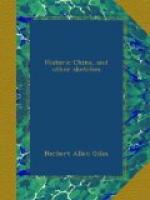JOURNALISM
Were any wealthy philanthropist to consult us as to the disposal of his millions with a view to ensure the greatest possible advantages to the greatest possible number, we should unhesitatingly recommend him to undertake the publication of a Chinese newspaper, to be sold at a merely nominal figure per copy. Under skilled foreign guidance, and with the total exclusion of religious topics, more would be effected in a few years for the real happiness of China and its ultimate conversion to western civilisation, than the most hopeful enthusiast could venture to predict. The Shun-pao, edited in Shanghai by Mr Ernest Major, is doing an incredible amount of good in so far as its influence extends; but the daily issue of this widely-circulated paper amounts only to about four thousand copies, or one to every hundred thousand natives! Missionary publications are absolutely useless, as they have a very limited sale beyond the circle of converts to the faith; but a colporteur of religious books informed us the other day that he was continually being asked for the Shun-pao. Now the Shun-pao owes its success so far to the fact that it is a pure money speculation, and therefore an undertaking intelligible enough to all Chinamen. Not only are its columns closed to anything like proselytising articles, but they are open from time to time to such tit-bits of the miraculous as are calculated to tickle the native palate, and swell the number of its subscribers. Therefore, to avert suspicion, it would be necessary to make a charge, however small, while at the same time such bogy paragraphs as occasionally appear in the columns of the Shun-pao might be altogether omitted.
Our attention was called to this matter by a charming description in the Shun-pao of a late balloon ascent from Calais, which was so nearly attended with fatal results. Written in a singularly easy style, and going quite enough into detail on the subject of balloons generally to give an instructive flavour to its remarks, this article struck us as being the identical kind of “light science for leisure hours” so much needed by the Chinese; and it compared most favourably with a somewhat heavy disquisition on aeronautic topics which appeared some time back in the Peking Magazine, albeit the latter was accompanied by an elaborate woodcut of a balloon under way. There is so much that is wonderful in the healthy regions of fact which might with mutual advantage be imparted to a reading people like the Chinese, that it is quite unnecessary to descend to the gross, and too often indecent, absurdities of fiction. Much indeed that is not actually marvellous might be put into language which would rivet the attention of Chinese readers. The most elementary knowledge, according to our standard, is almost always new, even to the profoundest scholar in native literature:




